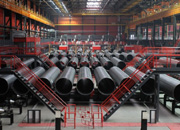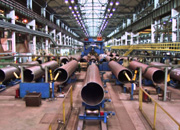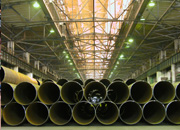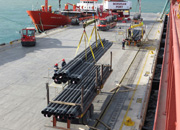Q235GJC straight seam welded steel pipe is a welded steel pipe widely used in the fields of construction, machinery manufacturing, bridge construction, etc., with excellent mechanical properties and welding performance. As a special grade of Q235 steel, Q235GJC straight seam steel pipe can meet more demanding engineering application scenarios through specific production processes and quality control while maintaining the characteristics of the basic material.
The basic material of Q235GJC straight seam welded steel pipe is Q235 steel, which is a common carbon structural steel with good weldability, plasticity, and toughness. The chemical composition of Q235 steel mainly includes elements such as carbon, silicon, manganese, phosphorus, and sulfur, among which the carbon content is controlled between 0.14%-0.22%, which ensures the balance between the strength and weldability of the steel. As an improved model of Q235 steel, Q235GJC further improves the comprehensive performance of the steel through the optimization of microalloying and heat treatment processes while maintaining the basic chemical composition. The yield strength of this steel reaches more than 235MPa, the tensile strength is between 375-500MPa, and the elongation is not less than 26%, which fully meets the requirements of national standards such as GB/T3091-2015 "Welded Steel Pipe for Low-Pressure Fluid Transportation".
In terms of production technology, Q235GJC straight seam welded steel pipe is mainly manufactured by high-frequency resistance welding (ERW) process. This process uses the skin effect and proximity effect generated by the high-frequency current to quickly heat the edge of the steel strip to the welding temperature and realizes the metallurgical bonding of the metal under the action of the extrusion roller. The entire production process includes uncoiling, leveling, shearing butt welding, loop storage, forming, welding, removing internal and external burrs, cooling, sizing, cutting, and other processes. Among them, welding temperature control, extrusion force, and cooling speed are the key parameters affecting the quality of the weld. Modern production lines generally use non-destructive testing technologies such as online ultrasonic flaw detection and eddy current flaw detection to ensure that the weld quality of each steel pipe meets the standard requirements. Compared with spiral welded pipes, straight seam welded steel pipes have the advantages of high dimensional accuracy, small ovality, short welds, and stable quality, and are particularly suitable for occasions with strict dimensional requirements.
In terms of application areas, Q235GJC straight seam welded steel pipes are widely used in multiple industries due to their excellent performance and reasonable price. In the construction field, it is often used for load-bearing components such as columns, beams, and roof trusses of steel structure buildings, as well as building scaffolding systems. Compared with traditional angle steel and channel steel, welded steel pipes have the advantages of lightweight, high strength, and convenient construction. In the machinery manufacturing industry, Q235GJC straight seam steel pipes are used as components such as frames, conveyor rollers, and hydraulic cylinders of various mechanical equipment. Its good processing performance allows secondary processing such as cutting, drilling, and welding. In bridge engineering, this steel pipe is often used to make pier supports, guardrails, and temporary construction brackets. Its high strength and good seismic resistance provide a guarantee for bridge safety.
In terms of quality control, the production of Q235GJC straight seam welded steel pipes strictly implements a number of national standards and industry standards. In addition to GB/T3091, related standards include GB/T13793 "Straight Seam Electric Welded Steel Pipe" and GB/T6728 "Dimensions, Shapes, Weights and Allowable Deviations of Cold-Formed Hollow Steel for Structural Use". These standards have detailed provisions for the dimensional tolerances, mechanical properties, process properties, and inspection rules of steel pipes. High-quality production enterprises will also pass ISO9001 quality management system certification and regularly accept supervision and spot checks by third-party testing agencies to ensure the stability and reliability of product quality. For steel pipes for special purposes, such as high-pressure fluid transportation or use in low-temperature environments, more stringent pressure tests and low-temperature impact tests are required.
Technological innovation is an important driving force for the development of Q235GJC straight seam welded steel pipes. In recent years, the welded pipe industry has made significant progress in many technical fields. In terms of forming technology, the use of a progressive forming process instead of traditional row roller forming effectively reduces the residual stress in the steel pipe forming process and improves dimensional accuracy. In the field of welding technology, the application of high-frequency welding energy density control technology makes the weld quality more stable and reliable, and the width of the heat-affected zone is reduced by more than 30%. In terms of detection technology, the introduction of advanced methods such as phased array ultrasonic detection and digital radiographic detection has greatly improved the defect detection rate and positioning accuracy. In addition, the improvement of automation is also an obvious trend in the development of the industry. The increasing popularity of fully automated production lines from raw material loading to finished product packaging not only improves production efficiency but also reduces the impact of human factors on product quality.
Looking to the future, the Q235GJC straight seam welded steel pipe industry will face new opportunities and challenges. From the perspective of market demand, the construction of new urbanization, urban renewal and transformation, and the implementation of the rural revitalization strategy will continue to drive the demand for steel pipes for construction; the increase in infrastructure investment such as oil and gas transportation and water conservancy projects will also create new market space. In terms of technological development, the in-depth application of intelligent manufacturing will further improve production efficiency and product quality stability; the combination of new materials and new processes may give birth to new welded pipe products with higher strength and better corrosion resistance. At the same time, the industry is also facing challenges such as fluctuations in raw material prices, increased environmental protection requirements, and intensified market competition. Enterprises need to respond to these challenges through technological innovation, management optimization, and differentiated competition.
In general, as a mature and continuously improving engineering material, Q235GJC straight seam welded steel pipe plays an irreplaceable role in the national economic construction. Its excellent performance, wide application, and continuous innovation enable it to maintain strong competitiveness in various engineering projects. With the transformation and upgrading of China's manufacturing industry and the continuous advancement of infrastructure construction, the Q235GJC straight seam steel pipe industry is expected to achieve higher-quality development and provide better products and services for various industries. For users, understanding the characteristics and applications of this material will help them make more reasonable choices in engineering projects and achieve the best balance between economic benefits and technical performance.
 Threeway Steel is known as a professional supplier engaged in manufacturing and distributing a wide range of steel pipe, and our headquarter located the central part of China – Hunan and six associated factories throughout China.
Threeway Steel is known as a professional supplier engaged in manufacturing and distributing a wide range of steel pipe, and our headquarter located the central part of China – Hunan and six associated factories throughout China.
 Threeway Steel is known as a professional supplier engaged in designing, manufacturing and distribution of a wide range of steel products with the headquarter located the central part of China – Hunan and six associated factories throughout China.
Threeway Steel is known as a professional supplier engaged in designing, manufacturing and distribution of a wide range of steel products with the headquarter located the central part of China – Hunan and six associated factories throughout China.
 Threeway Steel is known as a professional supplier engaged in designing, manufacturing and distribution of a wide range of steel products with the headquarter located the central part of China – Hunan and six associated factories throughout China.
Threeway Steel is known as a professional supplier engaged in designing, manufacturing and distribution of a wide range of steel products with the headquarter located the central part of China – Hunan and six associated factories throughout China.
 Threeway Steel is known as a professional supplier engaged in designing, manufacturing and distribution of a wide range of steel products with the headquarter located the central part of China – Hunan and six associated factories throughout China.
Threeway Steel is known as a professional supplier engaged in designing, manufacturing and distribution of a wide range of steel products with the headquarter located the central part of China – Hunan and six associated factories throughout China.
 Threeway Steel is known as a professional supplier engaged in designing, manufacturing and distribution of a wide range of steel products with the headquarter located the central part of China – Hunan and six associated factories throughout China.
Threeway Steel is known as a professional supplier engaged in designing, manufacturing and distribution of a wide range of steel products with the headquarter located the central part of China – Hunan and six associated factories throughout China.

